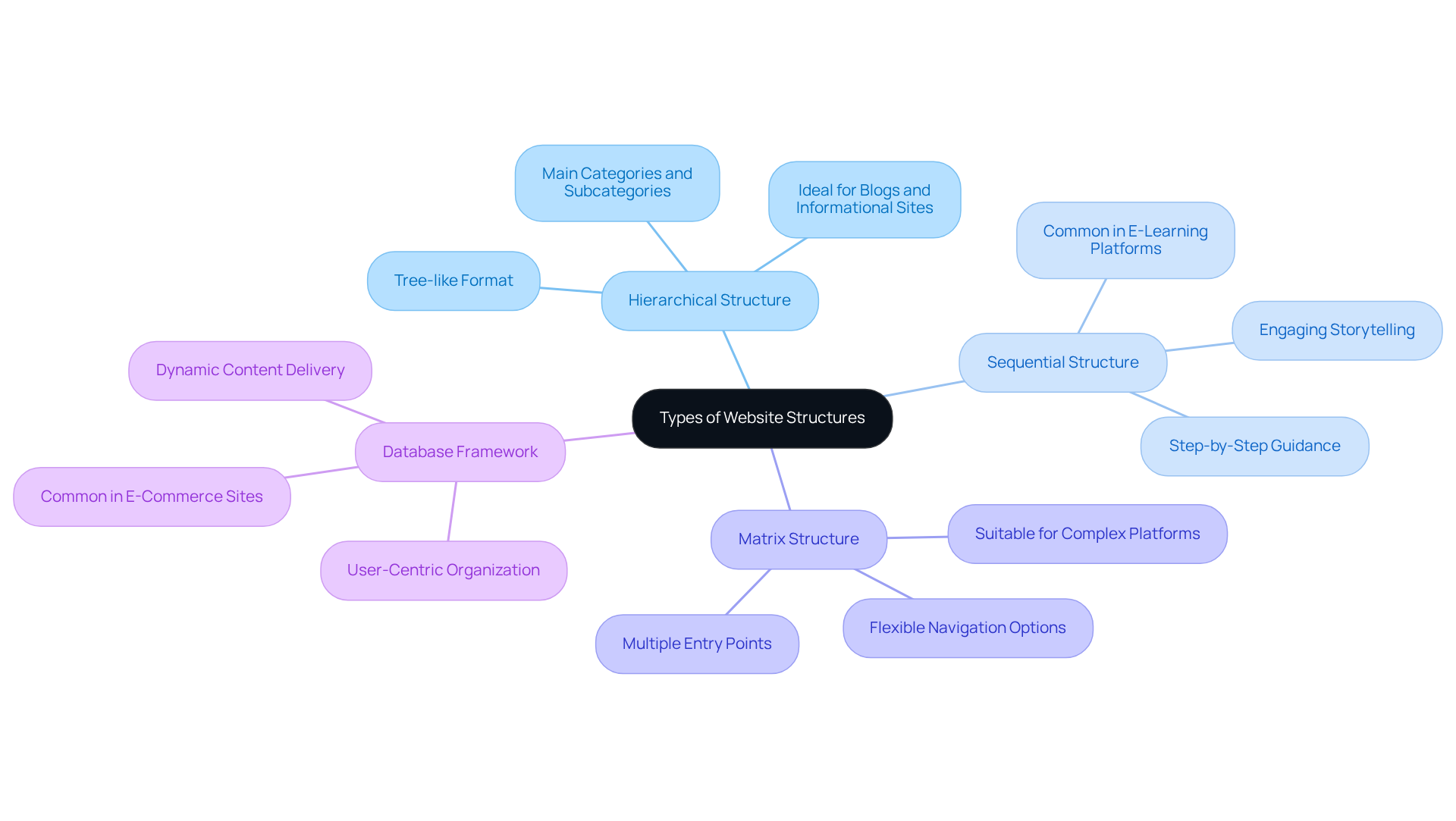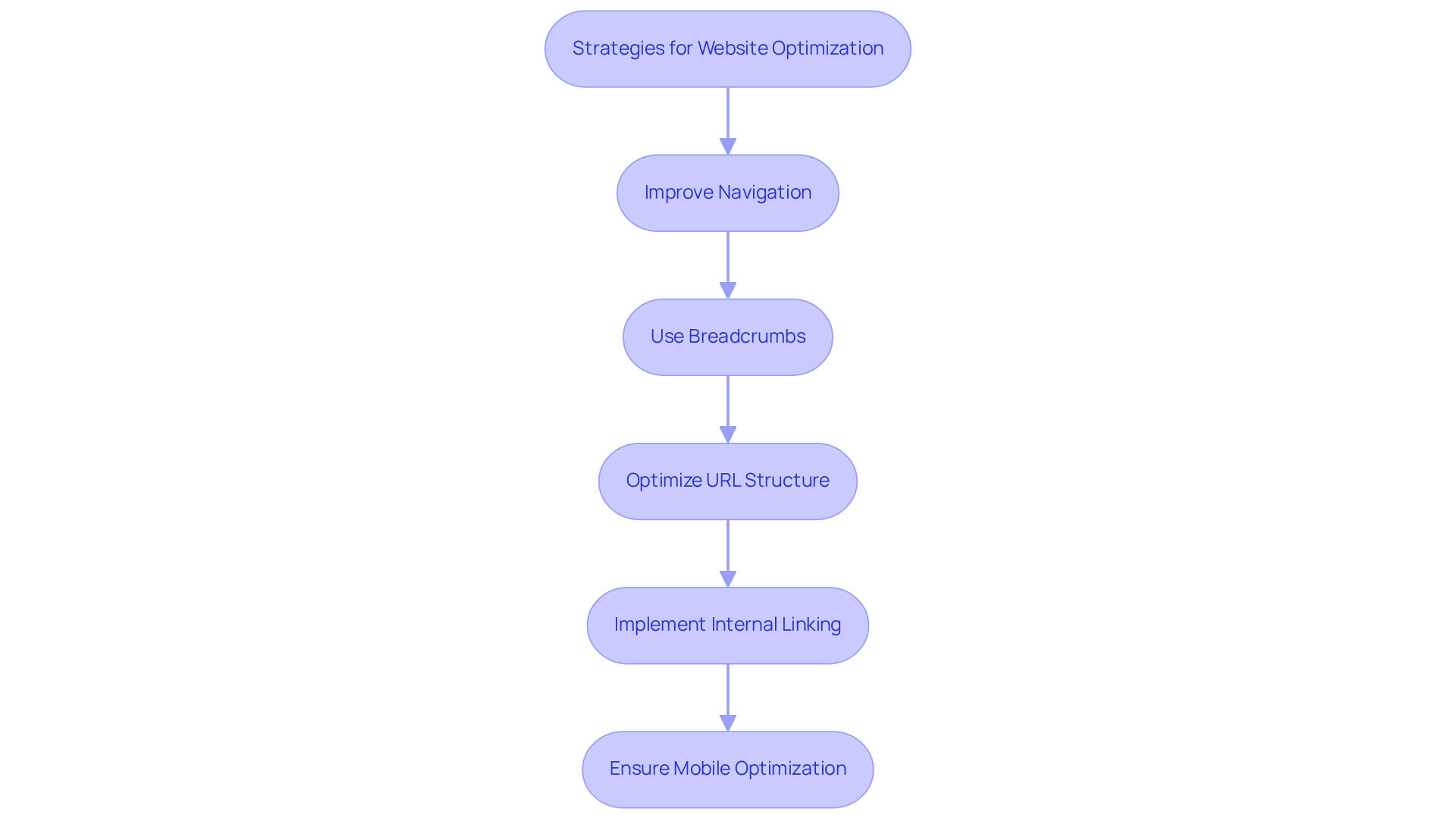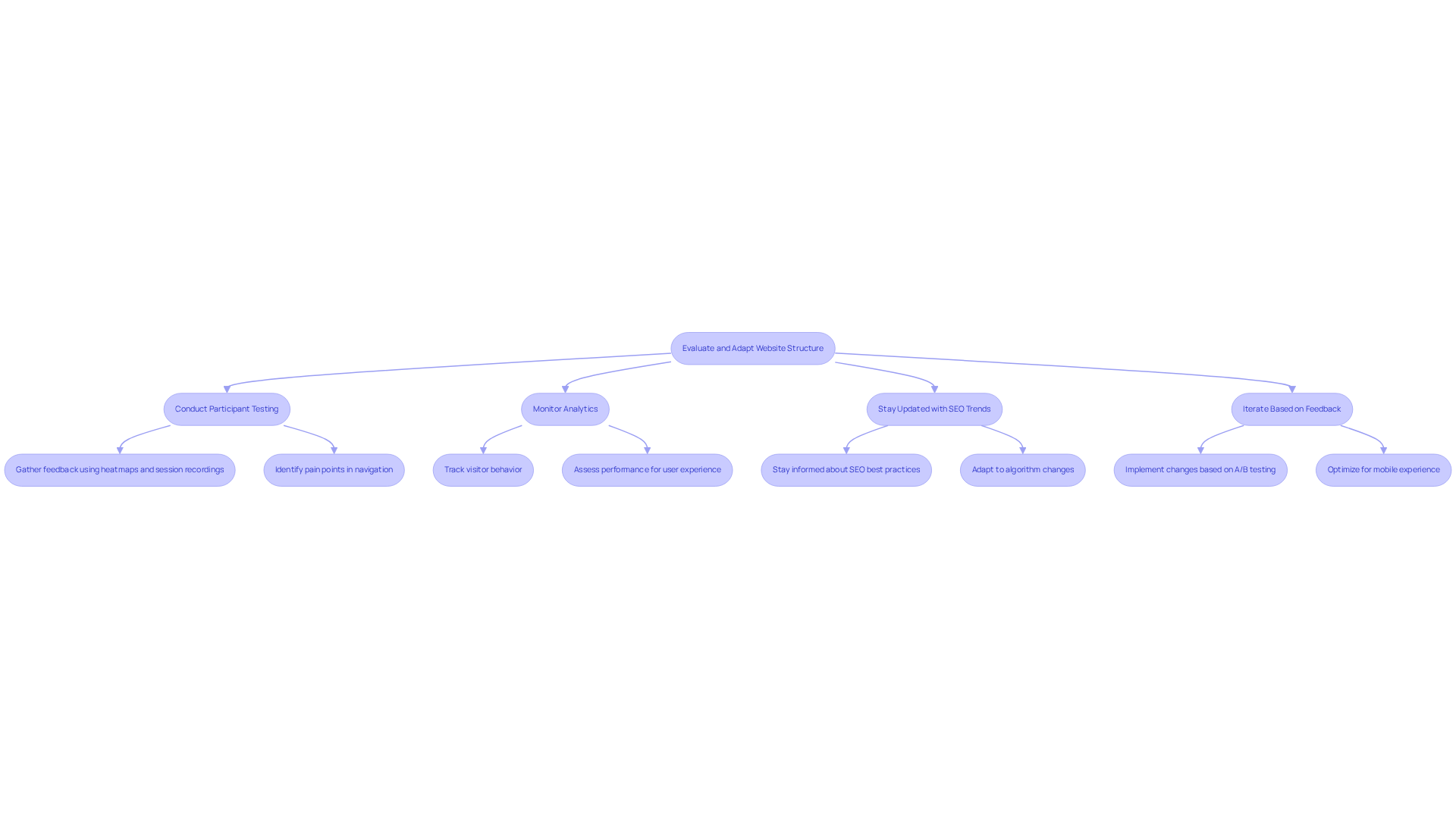Overview
In today’s digital landscape, many tech startup founders face the challenge of creating a website that not only attracts visitors but also keeps them engaged. A disorganized website can lead to frustration for users and hinder search engines from effectively crawling your content. This can result in missed opportunities for engagement and conversion, leaving you feeling overwhelmed.
However, there is hope. Mastering the structure of your website is essential for optimizing user experience and improving SEO performance. When your website is well-organized, it facilitates easier navigation for users, allowing them to find what they need quickly and effortlessly. This, in turn, enables search engines to crawl your site more efficiently, enhancing your visibility online.
By focusing on these elements, you can create a nurturing environment that fosters higher engagement and conversion rates. Imagine the relief of knowing that your website is not only user-friendly but also optimized for search engines. At RNO1, we understand the emotional and professional needs of startup founders, and we are here to support you in this journey. Together, we can transform your website into a powerful tool that resonates with your audience and drives success.
Introduction
The architecture of a website is crucial in shaping user experience and optimizing search engine performance. Many website owners find themselves struggling with creating an intuitive layout that meets the needs of both users and search engines.
This challenge can lead to frustration, as a poorly structured site can hinder navigation, increase bounce rates, and ultimately affect engagement and conversion rates. But you are not alone in this journey.
How can you master the art of website structure to ensure a seamless experience for your visitors while also addressing the demands of SEO? This article is here to guide you through essential strategies and best practices for structuring a website that not only captivates users but also drives your success.
Together, we will explore ways to create a nurturing online environment that fosters connection and growth.
Understand the Importance of Website Structure for User Experience and SEO
The structure of the website is a crucial element that significantly impacts both visitor experience and SEO efficiency. Many individuals struggle to navigate poorly structured platforms, leading to frustration and lost opportunities. When visitors cannot find information quickly or interact with content easily, it diminishes their experience and can drive them away.
Search engines, particularly Google, favor pages with a clear structure of website because it facilitates efficient crawling and indexing. Imagine a hierarchical structure of website where primary categories branch into subcategories; this not only aids understanding for individuals but also helps search engines grasp the arrangement of content. This audience-focused approach can substantially decrease bounce rates and enhance conversion rates.
When a site is intuitive and easy to navigate, individuals are more likely to stay and engage with the content. In fact, statistics reveal that 53% of individuals will abandon a mobile platform if it takes longer than three seconds to load, underscoring the importance of responsive design. Moreover, a mere one-second delay in page response can lead to a 7% reduction in conversions, illustrating how crucial loading times are for engagement.
With individuals spending over five hours each day on mobile devices, browsing various platforms and applications, it is essential to enhance online layouts for mobile audiences. Therefore, dedicating time to organize the structure of your website thoughtfully is vital for improving visitor experience and achieving better search engine rankings.
As Ketan Rajput insightfully states, 'Human-centered design puts end users at the center of the design process.' This reinforces the value of a user-focused approach. As the digital landscape evolves, prioritizing a strategic online framework will be essential for brands striving to thrive in 2025 and beyond.

Explore Different Types of Website Structures: Hierarchical, Sequential, and More
Choosing the right structure of website can be overwhelming, especially when you want to ensure that your audience can effortlessly find what they need. There are several types of website structures, each serving different purposes:
- Hierarchical Structure: This is the most common type, where information is organized in a tree-like format. Main categories extend into subcategories, facilitating easy exploration of specific topics.
- Sequential Structure: Frequently utilized in e-learning platforms or guided processes, this structure directs individuals through a series of steps in a specific order.
- Matrix Structure: This enables individuals to select their route through the content, offering various navigation options. It’s beneficial for intricate platforms with diverse content.
- Database Framework: Frequently found in eCommerce platforms, this framework arranges content according to user inquiries and preferences, enabling dynamic content delivery.
Selecting the appropriate framework can significantly impact the structure of website and how effectively your content resonates with your audience. For instance, a hierarchical arrangement is perfect for blogs or informational websites, whereas a database format is more appropriate for eCommerce platforms. Understanding these nuances can help you create a more engaging and user-friendly experience, fostering a deeper connection with your visitors.

Implement Best Practices for Structuring Your Website: Strategies for Optimization
To effectively optimize the structure of a website, it’s essential to recognize the common challenges many face in this area. A significant issue is often inadequate navigation, which can frustrate users and lead to page abandonment. Research shows that 61% of web designers believe poor navigation is a major reason for users leaving a site. Additionally, 88% of online consumers are less likely to return to a website after a negative experience, underscoring the importance of creating a user-friendly environment.
One effective solution is to create a clear navigation menu. An intuitive main navigation menu is crucial, reflecting the hierarchy of your content. Descriptive labels for categories and subcategories help users quickly find what they need, fostering a more positive experience.
Another helpful practice is to employ breadcrumbs. This feature greatly improves navigation by showing users their current position within the platform’s layout. It allows individuals to backtrack easily, enhancing their overall experience. By implementing breadcrumbs effectively, you can create a more organized site structure that facilitates exploration of related content.
Additionally, optimizing your URL structure is vital. Clean, descriptive URLs that reflect your content hierarchy not only assist in SEO but also improve comprehension of page content. A well-organized URL can enhance click-through rates and build trust with your visitors.
It’s also beneficial to implement internal linking. By strategically connecting related content within your platform, you guide users and enhance SEO. This practice helps search engines understand the relationships between different pages, ultimately improving your site’s visibility.
Lastly, consider mobile optimization. With over fifty percent of global web traffic coming from mobile devices, ensuring that your online presence is adaptable and mobile-friendly is crucial. A seamless mobile experience can significantly reduce bounce rates, which average 51% on mobile devices.
By implementing these strategies, you can create a user-centric platform that enhances engagement and drives conversions, ultimately improving the structure of the website for a more successful online presence. For instance, EcoFoil experienced an 86% increase in purchases after redesigning their homepage, showcasing the tangible benefits of effective online organization. As Matt Loy, an IT professional, emphasizes, "His commitment to transforming businesses and enhancing their digital presence has led to strategic initiatives that consistently exceed client expectations."
Remember, you’re not alone in this journey. By focusing on these nurturing strategies, you can create a welcoming and effective online space for your users.

Evaluate and Adapt Your Website Structure Regularly for Continuous Improvement
Maintaining an effective website layout can feel overwhelming, especially when faced with the constant demands of user expectations. Regular evaluation and adaptation are essential to navigate this challenge. Let’s explore some key strategies that can foster continuous improvement and support your journey:
-
Conduct Participant Testing: Gathering feedback from participants is crucial to identify those frustrating pain points in navigation and structure. Tools like heatmaps and session recordings can provide valuable insights into user behavior, helping you uncover areas that need attention. Research suggests that testing with just five participants can reveal up to 85% of usability issues, making it a cost-effective approach. However, it’s concerning that only 55% of companies engage in any form of online usability testing for their websites, indicating a significant opportunity for growth.
-
Monitor Analytics: Tracking visitor behavior through analytics tools is vital. Did you know that 88% of individuals are less likely to return to a site after a negative experience? This highlights the need for continuous performance assessment. Companies that prioritize user experience not only see increased revenue and conversions but also enjoy higher customer satisfaction. Moreover, data-driven organizations are 23 times more likely to acquire new customers, reinforcing the importance of leveraging analytics for informed decision-making.
-
Stay Updated with SEO Trends: The landscape of SEO best practices is ever-changing. Staying informed about shifts in algorithms and audience behavior is essential to maintain visibility and ensure that your website structure aligns with current standards.
-
Iterate Based on Feedback: Embrace the necessity of implementing changes based on feedback and analytics insights. A/B testing can effectively assess the impact of structural changes, allowing for data-driven modifications that enhance user experience. Remember, 67% of individuals prefer to engage with mobile-friendly platforms, emphasizing the importance of mobile optimization in your design approach.
By committing to regular assessment and adjustment, you can ensure that the structure of your website remains effective and aligned with visitor expectations, ultimately driving engagement and conversions. Investing in user experience improvements is crucial; after all, 80% of users are likely to pay more for a better experience. You’re not alone in this journey—by prioritizing these strategies, you can create a website that truly resonates with your audience.

Conclusion
The structure of a website is crucial in shaping user experience and enhancing SEO performance. Many founders may find that a disorganized site leads to frustrating navigation for visitors and challenges for search engines trying to crawl and index content. This can result in higher bounce rates and missed opportunities for conversion. By embracing a user-centered design, brands can create a more engaging online environment that truly resonates with their audience.
Reflecting on different website structures, we see options like:
- Hierarchical
- Sequential
- Matrix
- Database
Each designed to meet various user needs. Implementing best practices—such as clear navigation menus, breadcrumbs, optimized URL structures, and mobile responsiveness—can foster a seamless experience for users. It’s equally important to regularly evaluate and adapt the website layout, ensuring it evolves alongside changing user expectations and SEO trends.
In conclusion, taking a strategic approach to website structure is essential for success in the digital landscape. By committing to continuous improvement and user-centric design, businesses can enhance their online presence, drive engagement, and ultimately achieve greater success. Embracing these practices not only enriches the user experience but also positions brands to thrive in an increasingly competitive market. Remember, every step taken towards understanding and improving your website structure is a step towards creating a nurturing space for your users.
Frequently Asked Questions
Why is website structure important for user experience?
A well-structured website enhances user experience by making it easier for visitors to navigate and find information quickly. Poorly structured platforms can frustrate users and lead to lost opportunities.
How does website structure affect SEO?
Search engines, especially Google, prefer websites with a clear structure because it aids in efficient crawling and indexing. A hierarchical structure helps both users and search engines understand the arrangement of content.
What is the impact of a clear website structure on bounce rates and conversions?
An intuitive and easy-to-navigate website can substantially decrease bounce rates and enhance conversion rates, as users are more likely to stay and engage with the content.
What statistics highlight the importance of loading times for mobile users?
Statistics reveal that 53% of individuals will abandon a mobile platform if it takes longer than three seconds to load, and a one-second delay in page response can lead to a 7% reduction in conversions.
How much time do individuals spend on mobile devices daily?
Individuals spend over five hours each day on mobile devices, browsing various platforms and applications.
What is the significance of responsive design in website structure?
Responsive design is crucial as it ensures that websites load quickly and are easy to navigate on mobile devices, which is essential for improving user experience and maintaining engagement.
What is the key takeaway from Ketan Rajput regarding website design?
Ketan Rajput emphasizes that 'Human-centered design puts end users at the center of the design process,' highlighting the importance of a user-focused approach in website structure.
Why is it vital to organize the structure of a website thoughtfully?
Thoughtfully organizing the structure of a website is vital for improving visitor experience and achieving better search engine rankings, which is essential for brands aiming to thrive in the evolving digital landscape.




